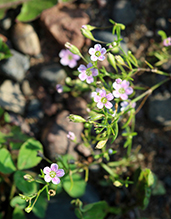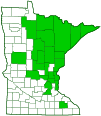Low baby’s-breath
(Psammophiliella muralis)
Conservation • Description • Habitat • Ecology • Use • Distribution • Taxonomy
Conservation Status |
|||
| IUCN Red List | not listed |
||
| NatureServe | NNA - Not applicable SNA - Not applicable |
||
| Minnesota | not listed |
||
Description
Low baby’s-breath is an exotic, annual, herbaceous, flowering plant. It is native to Europe and eastern Asia. Evidence of its escape from cultivation (naturalization) was documented in Minnesota as early as 1910-1911, which suggests that it was introduced to North America as a garden ornamental and escaped well before that. Its spread has been slow, often aided by human intervention. For example, its spread in Eau Claire, Wisconsin include sites where snow and ice have been piled in winter. It now occurs in the United States from Maine to New Jersey, west to Minnesota, South Dakota, and Illinois, and there are scattered records around major metropolitan areas throughout the country. It occurs in southern Canada from Nova Scotia to Ontario, also with scattered records farther west.
Low baby’s-breath is found in yards, cemeteries, roadsides, and other disturbed sites. It is often found in sidewalk cracks. It grows under full sun in sandy or rocky soil.
The stems are erect, 1½″ to 11¾″ (4 to 30 cm) long, and much branched, with branches spreading in all directions throughout. The lower stem is usually covered with minute, fine, short hairs and the upper stem is hairless. Occasionally the entire stem is hairless.
The leaves are oppositely arranged. Opposite leaves are joined at the base around the stem at first. Later they are stalkless but the blades do not clasp the stem. The blade is linear, ⅛″ to 1¼″ (3 to 32 mm) long, and 1⁄128″ to ⅛″ (0.2 to 2.5 mm) wide. It is narrowly angled to convex at the tip. The upper and lower surfaces are hairless, but they are not covered with a whitish, waxy or powdery film (glaucous).
Each flower is on a hairless, 1⁄16″ to ¾″ (2 to 20 mm) long stalk. There are 5 outer floral leaves (sepals), 5 petals, 10 stamens, and 2 styles. The sepals are joined into a green, 1⁄16″ to ⅛″ (2 to 4 mm) long, cup-like base (calyx). The calyx has five lobes with rounded to broadly angled tips. The petals are inversely lance-shaped, ⅛″ to ¼″ (3.5 to 6.0 mm) long or longer, and usually pink, rarely white. The stamens are as long or longer than the calyx. The style is short.
The fruit is an egg-shaped to ellipse-shaped capsule that is slightly longer than the calyx. It contains numerous seeds.
Height
1½″ to 11¾″ (4 to 30 cm)
Flower Color
Usually pink
Similar Species
Baby's breath (Gypsophila paniculata) flowers are usually white, rarely pink.
Habitat
Yards, cemeteries, roadsides, disturbed sites, and sidewalk cracks
Ecology
Flowering
Summer and fall
Pests and Diseases
Use
Low baby’s-breath and non-native Gypsophila species are widely planted as garden ornamentals.
Distribution |
||
|
Sources Biodiversity occurrence data published by: Minnesota Biodiversity Atlas (accessed through the Minnesota Biodiversity Atlas Portal, bellatlas.umn.edu, 10/7/2025). |
|
| 10/7/2025 | ||
Nativity |
||
Native to Europe, Asia, and the Indian subcontinent. Introduced and naturalized in North America. |
||
Occurrence |
||
|
||
Taxonomy
Kingdom
Plantae (green algae and land plants)
Subkingdom
Viridiplantae (green plants)
Infrakingdom
Streptophyta (land plants and green algae)
Superdivision
Division
Tracheophyta (vascular plants)
Subdivision
Spermatophytina (seed plants)
Class
Magnoliopsida (flowering plants)
Subclass
Caryophyllidae
Superorder
Caryophyllanae
Order
Caryophyllales (pinks, cactuses, and allies)
Family
Caryophyllaceae (pink)
Subfamily
Caryophylloideae
Tribe
Caryophylleae
Genus
Psammophiliella
Genus
This species was first described by Carl Linnaeus in 1753 as Gypsophila muralis. In 1976, the Russian botanist Sergei Sergeevich Ikonnikov proposed moving it to a new genus due to morphological differences. He named it Psammophiliella muralis. The move is supported by recent phylogenetic studies (molecular analyses), which have shown that Gypsophila, as traditionally defined, is not monophyletic, meaning it does not include all the descendants of a single common ancestor. The name Gypsophila muralis is now widely treated as a synonym of Psammophiliella muralis.
Subordinate Taxa
Synonyms
Dichoglottis muralis
Gypsophila agrestis
Gypsophila arvensis
Gypsophila filiformis
Gypsophila muralis
Gypsophila muralis ssp. serotina
Gypsophila muralis ssp. stepposa
Gypsophila muralis var. gracillima
Gypsophila muralis var. major
Gypsophila muralis var. matura
Gypsophila muralis var. minor
Gypsophila muralis var. serotina
Gypsophila muralis var. stenopetala
Gypsophila muralis var. stepposa
Gypsophila purpurea
Gypsophila pyrenaica
Gypsophila serotina
Gypsophila stepposa
Psammophila muralis
Psammophila stepposa
Psammophiliella stepposa
Saponaria muralis
Silene muralis
Common Names
annual gypsophila
low babysbreath
low baby’s-breath
Glossary
Glaucous
Pale green or bluish gray due to a whitish, powdery or waxy film, as on a plum or a grape.
Linear
Long, straight, and narrow, with more or less parallel sides, like a blade of grass.
Sepal
An outer floral leaf, usually green but sometimes colored, at the base of a flower.
Visitor Photos
Share your photo of this plant.
This button not working for you?
Simply email us at info@MinnesotaSeasons.com.
Attach one or more photos and, if you like, a caption.
Gary Walton |
 |
This one is growing in my driveway. I think the origin of the seeds is from the road shoulder on Old Highway 53 in Britt, MN. Seeds were probably transported in my tire tracks over the years, and some eventually made it to my driveway and grew. Two other species of plants also appeared in my driveway around the same time: an Eragrostis sp. and Sporobolus vaginiflorus. |
MinnesotaSeasons.com Photos
|

Slideshows
Gypsophila muralis
orey.raimond
Psammophiliella muralis (L.) Ikonn., 1976
Thibault Lefort

Visitor Videos
Share your video of this plant.
This button not working for you?
Simply email us at info@MinnesotaSeasons.com.
Attach a video, a YouTube link, or a cloud storage link.
Other Videos
Gypsophila muralis / জিপসোফিলা মুরালিস / ATA Tech / floweres
ATA Agro

Visitor Sightings
Report a sighting of this Plant.
This button not working for you?
Simply email us at info@MinnesotaSeasons.com.
Be sure to include a location.
Gary Walton
8/18/2024
Location: Carlton County
This one is growing in my driveway. I think the origin of the seeds is from the road shoulder on Old Highway 53 in Britt, MN. Seeds were probably transported in my tire tracks over the years, and some eventually made it to my driveway and grew. Two other species of plants also appeared in my driveway around the same time: an Eragrostis sp. and Sporobolus vaginiflorus.
MinnesotaSeasons.com Sightings


